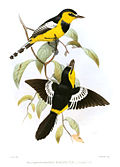| Mohoua | |
|---|---|
 | |
| Whitehead (Mohoua albicilla) | |
| Scientific classification | |
| Kingdom: | Animalia |
| Phylum: | Chordata |
| Class: | Aves |
| Order: | Passeriformes |
| Infraorder: | Corvides |
| Family: | Mohouidae Mathews, 1946 |
| Genus: | Mohoua Lesson, 1837 |
| Type species | |
| Certhia heteroclites [1] = Muscicapa ochrocephala Quoy & Gaimard, 1830 | |
Mohoua is a small genus of three bird species endemic to New Zealand. The scientific name is taken from mohua – the Māori name for the yellowhead. [2] Their taxonomic placement has presented problems: They have typically been placed in the whistler family, Pachycephalidae, but in 2013 it was established that they are best placed in their own family, Mohouidae. [3] A large molecular genetic study published in 2019 found that the family is sister to the family Neosittidae containing the three sittellas. [4]
Contents
All three species display some degree of sexual dimorphism in terms of size, with the males being the larger of the two sexes. [5] Mohoua are gregarious (more so outside the breeding season) and usually forage in groups. They also forage in mixed species flocks at times, frequently forming the nucleus of such flocks. [2] Social organization and behaviour is well documented for all three Mohoua species; cooperative breeding has been observed in all three species and is common in the whitehead and yellowhead. [2] The three species of this genus are the sole hosts for the long-tailed cuckoo which acts as a brood parasite upon them, pushing their eggs out of the nest and laying a single one of its own in their place so that they take no part in incubation of their eggs or in raising their young. [5]










